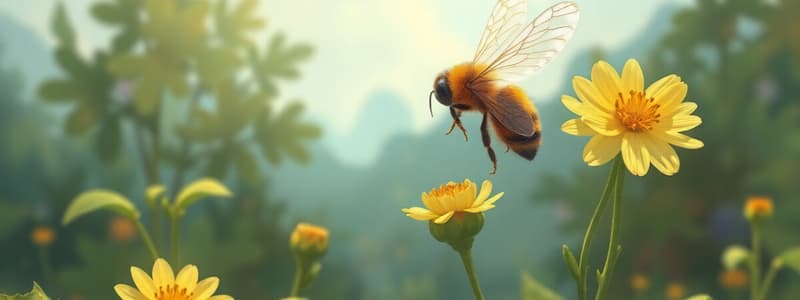Podcast
Questions and Answers
What is the primary function of pollination in the plant life cycle?
What is the primary function of pollination in the plant life cycle?
- To enable fertilization and the creation of seedlings. (correct)
- To facilitate the transfer of nutrients from the soil to the leaves.
- To protect plants from herbivores and environmental stressors.
- To produce vibrant colors and fragrances in flowers.
Which part of the plant is responsible for producing pollen?
Which part of the plant is responsible for producing pollen?
- Ovary
- Anther (correct)
- Petal
- Stigma
What distinguishes cross-pollination from self-pollination?
What distinguishes cross-pollination from self-pollination?
- Cross-pollination involves pollen transfer between different plants, whereas self-pollination occurs within the same plant. (correct)
- Cross-pollination results in seeds, while self-pollination results in spores.
- Cross-pollination only occurs in aquatic plants, while self-pollination occurs in terrestrial plants.
- Cross-pollination is facilitated by wind, while self-pollination is always facilitated by animals.
Which of the following is NOT mentioned as a common agent of cross-pollination?
Which of the following is NOT mentioned as a common agent of cross-pollination?
In the process of seedling formation, what event immediately follows the pollen entering the stigma?
In the process of seedling formation, what event immediately follows the pollen entering the stigma?
Which of these plants is given as an example of a self-pollinating plant?
Which of these plants is given as an example of a self-pollinating plant?
What is a characteristic feature of plants that rely on wind pollination?
What is a characteristic feature of plants that rely on wind pollination?
Which of the following best describes how seeds are dispersed after fertilization?
Which of the following best describes how seeds are dispersed after fertilization?
Trees and grasses are primarily pollinated through which method?
Trees and grasses are primarily pollinated through which method?
Where would you most likely find plants that use water for pollination?
Where would you most likely find plants that use water for pollination?
Flashcards
What is pollination?
What is pollination?
The process of transferring pollen from the male part of a plant (anther) to the female part (stigma) to fertilize the plant and create seeds.
What is cross-pollination?
What is cross-pollination?
The most common type of pollination where pollen moves from one plant to another, often with the help of animals like butterflies.
What are pollinators attracted to?
What are pollinators attracted to?
The bright colours, smells and shapes of plants that attract animals to help with pollination.
What is self-pollination?
What is self-pollination?
Signup and view all the flashcards
How does wind aid in pollination?
How does wind aid in pollination?
Signup and view all the flashcards
How does water aid in pollination?
How does water aid in pollination?
Signup and view all the flashcards
How are seeds dispersed?
How are seeds dispersed?
Signup and view all the flashcards
What is a seed?
What is a seed?
Signup and view all the flashcards
What is a seedling?
What is a seedling?
Signup and view all the flashcards
What happens after pollination?
What happens after pollination?
Signup and view all the flashcards
Study Notes
Pollination Overview
- Pollination is the transfer of pollen from a plant's anther (male part) to its stigma (female part), fertilizing the plant and creating seedlings.
Cross-Pollination
- Cross-pollination is the most common type.
- Plants attract animals (birds, insects) with bright colors, smells, and shapes.
- Animals carry pollen from one plant's anther to another's stigma.
- Example: A butterfly lands on a flower, pollen sticks to its legs, and is transferred to another flower.
Seedling Formation
- Pollen travels to the egg after landing on the stigma, fertilizing the plant.
- A seed forms which is dispersed by wind, water, animals, or humans.
- Animals can eat seeds and spread them through their waste.
Other Pollination Methods
- Self-pollination: Plants fertilize themselves without outside help (e.g., tomatoes).
- Wind-pollination: Plants with dry pollen and feathery flowers (e.g., trees and grasses) use wind to spread pollen.
- Water-pollination: Plants in ponds and lakes release pollen into the water to travel to other plants.
Importance of Pollination
- Pollination is crucial for plant reproduction.
- Plants provide food, clothing, shelter, oxygen, and habitat for animals.
- Without pollination, life on Earth as we know it would not exist.
Studying That Suits You
Use AI to generate personalized quizzes and flashcards to suit your learning preferences.




